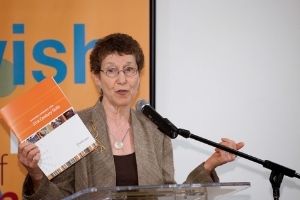Annual Meeting 2010!


But this wasn’t just any annual meeting! No, this was the annual meeting of our 50th year! We’ve been trying to celebrate our jubilee year with panache through special programs (like the re-dedication of Lloyd Street Synagogue in March) and putting just a little bit of extra sparkle on all our regular offerings. Our annual meeting was no different!



After sharing a number of stories, Gil thanked all past and present JMM trustees for their dedicated service to and support of the JMM. At the end of her talk, Marsha was surprised by the presentation of an Award of Appreciation to the IMLS, on behalf of Baltimore museums.

But before all of these illustrious speakers, the meeting was opened with a welcome from our own associate director Anita Kassof. Her remarks, which follow below, set the tone of the meeting and truly capture the direction of the museum’s gaze as we celebrate our 50th year.
As we began planning for our anniversary year, we batted around a number of potential taglines. One of my personal favorites, which, unfortunately, didn’t stick, was “Halfway to one hundred.”
What I like about that tagline is that it acknowledges that while anniversaries are an occasion to look backwards, they also offer an opportunity to look ahead. As a history museum, we do a good job of examining the past, interpreting it, and drawing messages and meaning from it. Our exhibitions exemplify our commitment to learning from our collective past: In Her Inward Eye, Nancy Patz’s works asks us to ponder the significance of memory. Voices of Lombard Street is a nostalgic journey that explores how community is shaped. The Synagogue Speaks, our newest exhibition, unearths the mysteries of a building that continues to reveal new secrets every time we dig a little deeper.

Our job is also to meet the future head on by embracing new ways to engage and inspire our visitors. To that end—with the help of the under-30 staff at the Museum—we’re diving into the social networking world by Facebooking, blogging, and developing an interactive microsite for our Chosen Food exhibition. And Tweeting is just down the road.

Just as I was pondering the role of social media and other new technologies in engaging visitors of the future, I learned that the theme of next year’s conference of the American Association of Museums is “The Museum of Tomorrow.”

Not a little anxiety accompanies these musings, as museum professionals—and our visiting public—envision how museums will look in the internet age. Wonderful opportunities await us. But as we enter uncharted territory in our march toward the future, I hope that we don’t lose sight of the value of traditional museums as places of discovery that offer authentic experiences. Sometimes, visitors find things in our exhibitions that surprise even us, as they interpret the authentic—a yellowed document, a snippet from an oral history, the brushstroke on a canvas—through the lens of their own experiences.

Our two historic synagogues—beautifully restored and interpreted—offer real encounters with material evidence of the past, showing how different people have used and shaped the buildings. Our collections, the largest and most varied of their kind, vividly illustrate our communal past. Our programs and exhibitions invite visitors to engage with real things in authentic settings. The Museum is truly a place of discovery—and of mystery—where visitors can encounter the unexpected. In the process, they may just find out more about themselves.
*All photographs by Will Kirk and Mark Mehlinger.
